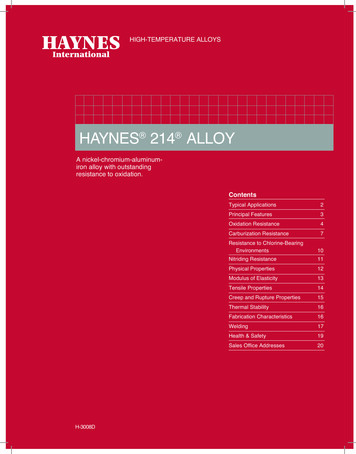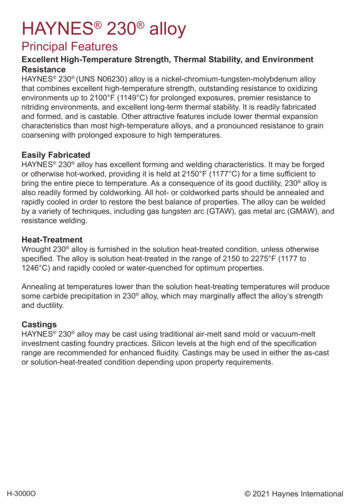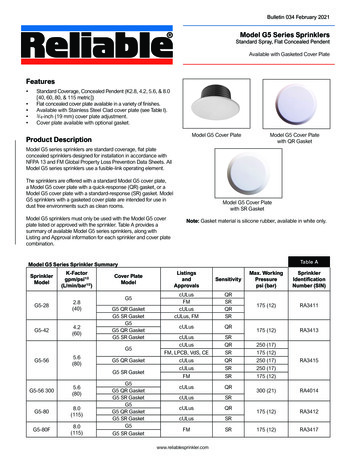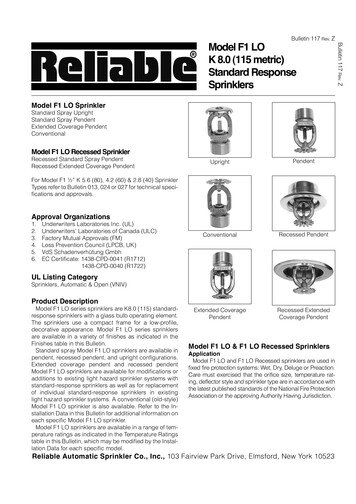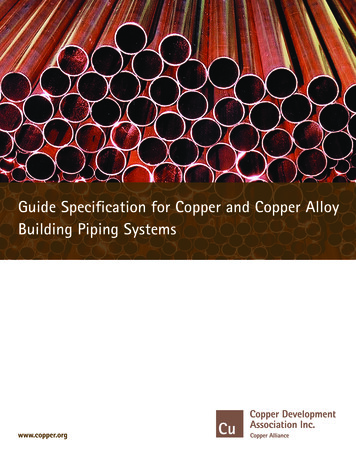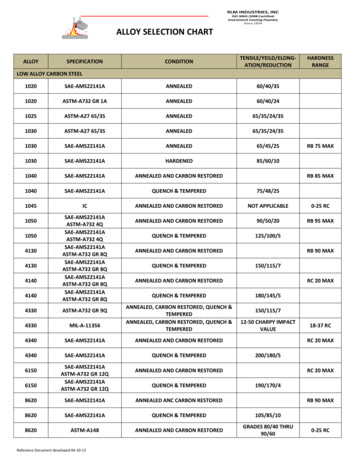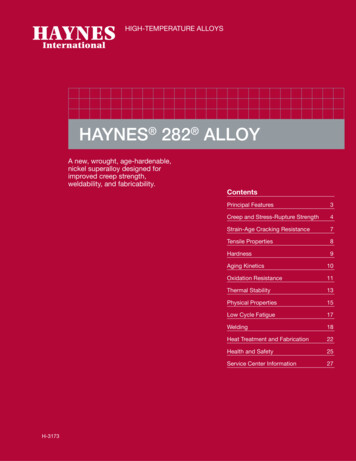
Transcription
HIGH-TEMPERATURE ALLOYSHAYNES 282 ALLOYA new, wrought, age-hardenable,nickel superalloy designed forimproved creep strength,weldability, and fabricability.ContentsH-3173Principal Features3Creep and Stress-Rupture Strength4Strain-Age Cracking Resistance7Tensile Properties8Hardness9Aging Kinetics10Oxidation Resistance11Thermal Stability13Physical Properties15Low Cycle Fatigue17Welding18Heat Treatment and Fabrication22Health and Safety25Service Center Information27
TYPICAL APPLICATIONSHAYNES 282 alloy is designed for applications in engines for aircraft.HAYNES 282 alloy is designed for the transition sections and otherhot-gas-path components in land-based gas turbines.HAYNES 282 alloy2 2008 Haynes International, Inc.
PRINCIPAL FEATURESExcellent High Temperature StrengthHAYNES 282 alloy is a new, wrought, gamma-prime strengthened superalloy developed for high temperaturestructural applications, especially those in aero and land-based gas turbine engines. It possesses a uniquecombination of creep strength, thermal stability, weldability, and fabricability not found in currently availablecommercial alloys. The new alloy has excellent creep strength in the temperature range of 1200 to 1700 F (649to 927 C), surpassing that of Waspaloy alloy, and approaching that of R-41 alloy.Easily FabricatedThis high level of creep strength in HAYNES 282 alloy has been attained at a relatively low volume fraction of thestrengthening gamma-prime phase, resulting in outstanding resistance to strain-age cracking (normally a problemwith superalloys in this creep strength range). Additionally, slow gamma-prime precipitation kinetics allow for thealloy to have excellent ductility in the as-annealed condition. Consequently, HAYNES 282 alloy exhibits superiorweldability and fabricability.Product FormsHAYNES 282 alloy is designed for use in the form of plate, sheet, strip, foil, billet, bar, wire welding products, pipe,and tubing.Heat TreatmentHAYNES 282 alloy is provided in the solution-annealed condition, in which it is readily formable. The typical solutionannealing temperature is in the range of 2050 to 2100 F (1121 to 1149 C). After component fabrication, a two-stepage hardening treatment is required to put the alloy into the high-strength condition. The treatment includes 1850 F(1010 C) / 2 hours / AC (air cool) 1450 F (788 C) / 8 hours / AC.ApplicationsThe features of HAYNES 282 alloy make it suitable for critical gas turbine applications, such as sheet fabrications,seamless and flash butt-welded rings, and cases found in compressor, combustor, and turbine sections. Inaugmented aircraft gas turbines, the new alloy will be useful for exhaust and nozzle components. In land-based gasturbines, HAYNES 282 alloy is a good candidate for transition sections and other hot-gas-path components.Nominal Chemical Composition, Weight %Ni57*** *0.060.005** Nickel as balance3HAYNES 282 alloy
CREEP AND STRESS-RUPTURE STRENGTHHAYNES 282 alloy possesses exceptional creep strength in the temperature range 1200-1700 F (649-927 C).For example, it has superior strength to 263 alloy at all temperatures in this range in terms of both 1% creep andrupture. Despite the exceptional fabricability of 282 alloy, it compares well to less fabricable alloys designed for highcreep strength. For example, its rupture strength is equivalent to the well-known, but less fabricable, Waspaloy alloyat the lower temperatures in this range and actually has a distinct advantage at the higher end of the temperaturerange. In terms of 1% creep strength, 282 alloy is superior to Waspaloy alloy across the entire temperature range.At temperatures of 1500-1700 F (816-927 C), 282 alloy has creep strength equivalent to even that of R-41 alloy, analloy designed for excellent creep strength, but notorious for poor fabricability.Creep Strength of Various Superalloysin the Temperature Range 1500-1700ºF (816-927ºC)(Sheet Products)24Larson-Miller Parameter (K x 10-3, C 20)25262728302010Stress (MPa)Stress (ksi)1009876543282 alloyR-41 alloyWaspaloy alloy263 alloy210142HAYNES 282 alloy44464850Larson-Miller Parameter ( R x 10-3, C 20)452
Comparative Creep-Rupture Properties of Gamma-Prime Strengthened Alloys* (Sheet)Test Temperature F 0081616008711700927PropertyStress-to-Produce1% Creepin 100 hksi (MPa)Stress-to-Produce1% Creepin 1000 hksi (MPa)Stress-to-ProduceRupture in 100 hksi (MPa)Stress-to-ProduceRupture in 1000 hksi (MPa)263 AlloyR-41 AlloyWaspaloyAlloy282 Alloy75 (517)54 (372)37 (255)22 (152)11 (76)6 (41)58 (400)41 (283)25 (172)12 (83)6 (41)3 (21)77 (531)60 (414)42 (290)25 (172)14 (97)7 (48)64 (441)45 (310)28 (193)15 (103)7 (48)4 (28)105 (724)75 (517)53 (365)32 (221)17 (117)8 (55)84 (579)59 (407)34 (234)18 (124)9 (62)5 (34)110 (758)85 (586)63 (434)39 (269)23 (159)13 (90)90 (621)68 (469)43 (296)24 (165)13 (90)7 (48)81 (558)63 (434)41 (283)25 (172)15 (103)6 (41)67 (462)46 (317)28 (193)16 (110)7 (48)3 (21)92 (634)75 (517)53 (365)32 (221)19 (131)10 (69)80 (552)58 (400)36 (248)20 (138)7 (48)3 (21)—72 (496)48 (331)32 (221)18 (124)9 (62)79 (545)53 (365)35 (241)21 (145)10 (69)5 (34)—75 (517)56 (386)37 (255)22 (152)12 (83)80 (552)56 (386)38 (262)23 (159)12 (83)6 (41)*Age-hardened (263 alloy: 1472 F (800 C)/8h/AC, Waspaloy alloy : 1825 F (996 C)/2h/AC 1550 F (843 C)/4h/AC 1400 F(760 C)/16h/AC, R-41 alloy: 1650 F (899 C)/4h/AC, 282 alloy: 1850 F (1010 C)/2h/AC 1450 F (788 C)/8h/AC)Solution Annealed* Age Hardened** 282 SheetTest Temperature FCreep 0.5 %1%Rupture0.5 %1%Rupture0.5 %1%Rupture0.5 %1%Rupture0.5 %1%Rupture0.5 %1%Rupture0.5 %1%RuptureApproximate Initial Stress, ksi (MPa)To Produce Specified Creep in:100 Hours———70 (483)72 (496)75 (517)46 (317)48 (331)56 (386)30 (207)32 (221)37 (225)17 (117)18 (124)22 (152)8.3 (57)9.0 (62)12 (83)3.6 (25)4.2 (29)5.5 (38)1,000 Hours78 (538)79 (545)80 (552)51 (352)53 (365)56 (386)33 (228)35 (241)38 (262)18 (124)21 (145)23 (159)9.0 (62)10 (69)12 (83)4.2 (29)5.0 (34)6.0 (41)—1.8 (12)2.5 (17)*2100 F (1149 C)**1850 F (1010 C)/2h/AC 1450 F (788 C)/8h/AC5HAYNES 282 alloy
Solution Annealed* Age Hardened** 282 PlateTest Temperature F C12006491300CreepApproximate Initial Stress, ksi (MPa)To Produce Specified Creep in:100 Hours1,000 Hours10,000 Hours0.5 %1%Rupture———81 (558)82 (565)85 (586)——64 (441)7040.5 %1%Rupture73 (503)75 (517)80 (552)53 (365)55 (379)61 (421)——45 (310)14007600.5 %1%Rupture49 (338)50 (345)57 (393)35 (241)36 (248)41 (283)——27 (186)15008160.5 %1%Rupture32 (221)34 (234)38 (262)20 (138)22 (152)25 (172)——14 (97)8710.5 %1%Rupture18 (124)19 (131)23 (159)11 (76)12 (83)14 (97)——8 (55)17009270.5 %1%Rupture9.4 (65)10 (69)13 (90)4.8 (33)5.2 (36)7.0 (48)——3.7 (26)18009820.5 %1%Rupture4.2 (29)4.6 (32)6.2 (43)1.8 (12)2.0 (14)3.6 (25)———1600*2075 F (1135 C)**1850 F (1010 C)/2h/AC 1450 F (788 C)/8h/ACHAYNES 282 alloy6
STRAIN-AGE CRACKING RESISTANCEResistance to strain-age cracking is a major attribute of HAYNES 282 alloy. As indicated in the chart below, 282 alloyapproaches the well-known 263 alloy in this regard, and possesses much higher resistance to strain-age crackingthan other nickel superalloys in its strength class (Waspaloy and R-41 alloys).Resistance to Strain-Age Cracking as Measured bythe Controlled Heating-Rate Tensile (CHRT) TestTest Temperature ( C)76040% Elongation30780800820840860282 alloyR-41 alloyWaspaloy alloy263 alloy20100140014501500Test Temperature ( F)15501600The CHRT test is an excellent measure of the resistance of gamma-prime strengthened superalloys to strain-agecracking. Samples of thickness 0.063” (1.6 mm), originally in the solution annealed condition, are heated to the testtemperature at a rate of 25-30 F (14-17 C) per minute, this being representative of a typical post-weld heat treatment.Tests are performed for each alloy over a range of temperatures. The susceptibility to strain-age cracking is relatedto the minimum tensile elongation observed within that temperature range (the higher the minimum elongation, thegreater is the resistance to strain-age cracking).For further information regarding this test, please refer to:1. R.W. Fawley, M. Prager, J.B. Carlton, and G. Sines, WRC Bulletin No. 150, Welding Research Council, New York, 1970.2. M.D. Rowe, “Ranking the Resistance of Wrought Superalloys to Strain-Age Cracking”, Welding Journal, 85 (2),pp. 27-s to 34-s, 2006.7HAYNES 282 alloy
TENSILE PROPERTIESAverage Tensile Properties of HAYNES 282 AlloySolution Annealed and Age-Hardened Sheet*Temperature ( F)0.2% Yield Strength (ksi)Ultimate Tensile Strength (ksi)% 60072.680.531170043.950.237180018.724.561Solution Annealed and Age-Hardened Plate*Temperature ( F)0.2% Yield Strength (ksi)Ultimate Tensile Strength (ksi)% Elongation% 1Solution Annealed and Age-Hardened Sheet* – Metric Units (INTERPOLATED)Temperature ( C)0.2% Yield Strength (MPa)Ultimate Tensile Strength (MPa)% 30239003964473410007511564Solution Annealed and Age-Hardened Plate* – Metric Units (INTERPOLATED)Temperature ( C)0.2% Yield Strength (MPa)Ultimate Tensile Strength (MPa)% Elongation% 0262990040445841561000751157798*Solution Annealing: Sheet at 2100 F (1149 C), Plate at 2075 F (1135 C)Age-Hardening: 1850 F (1010 C)/2h/AC 1450 F (788 C)/8h/ACHAYNES 282 alloy8
Comparative Yield Strengths of Age-Hardened* Sheet Materialat Room Temperature and 1600 F (871 C)At room temperature, HAYNES 282 alloy has a higher yield strength than 263 alloy, but is not as strong as R-41 andWaspaloy alloys, which contain higher gamma-prime phase contents. However, at higher temperatures typical of gasturbine component applications, 282 alloy exhibits excellent yield strength, surpassing that of 263 and Waspaloy,and approaching that of the less fabricable R-41 alloy.50600400Yield Strength (MPa)263 alloy75282 alloy100800Waspaloy alloy263 alloyYield Strength (ksi)1251000R-41 alloyR-41 alloy1501200282 alloyWaspaloy alloy17520025001600 F(871 C)RT*Age-hardened (263 alloy: 1472 F (800 C)/8h/AC, Waspaloy alloy : 1825 F (996 C)/2h/AC 1550 F (843 C)/4h/AC 1400 F (760 C)/16h/AC, R-41 alloy: 1650 F (899 C)/4h/AC, 282 alloy: 1850 F (1010 C)/2h/AC 1450 F (788 C)/8h/AC)HARDNESSAverage Room Temperature Hardness of HAYNES 282 AlloyFormSolution Annealed*Age-Hardened**SHEET90 Rb30 RcPLATE93 Rb32 RcBAR86 Rb29 Rc*Solution Annealing: Sheet at 2100 F (1149 C), Plate and Bar at 2075 F (1135 C)**Age-hardening: 1850 F (1010 C)/2h/AC 1450 F (788 C)/8h/AC9HAYNES 282 alloy
AGING KINETICSA key attribute of HAYNES 282 alloy is its sluggish gamma-prime precipitation kinetics which are highly desirablefor improved fabricability for two main reasons. One, the formation of gamma-prime during heat treatment is akey factor in strain age-cracking. Two, it allows sufficient time for the alloy to cool after solution annealing withoutformation of the gamma-prime phase which would reduce cold formability. The chart below indicates the increase inthe room-temperature hardness (an indicator of the precipitation of the gamma-prime phase) with increasing agingtime at 1500 F (816 C) for 282 alloy and several other gamma-prime strengthened alloys. 282 alloy was found tohave a sluggish response, similar to the readily fabricable 263 alloy. The less fabricable R-41 and Waspaloy alloyshardened much more quickly.Isothermal Hardening KineticsTemperature: 1500 F (816 C), Starting Material: Solution Annealed Sheet741500 F (816 C)Hardness (Ra)706662282 alloyR-41 alloyWaspaloy alloy263 alloy58541HAYNES 282 alloy10Time (minutes)101001,000
OXIDATION RESISTANCEStatic Oxidation TestingEnvironment: Flowing AirTest Duration: 1,008 hNumber of Cycles: 6Cycle Length: 168 hTemperatures: 1600, 1700, 1800 F (871, 927, 982 C)Metal Loss (A-B)/2Average Internal Penetration CMaximum Internal Penetration DAverage Metal Affected Metal Loss Average Internal PenetrationMaximum Metal Affected Metal Loss Maximum Internal Penetration1600 F (871 C)Metal LossAverage InternalPenetrationMaximum InternalPenetrationAverage MetalAffectedMaximum MetalAffectedmils (μm)mils (μm)mils (μm)mils (μm)mils (μm)282 Alloy0.2 (5)0.4 (10)1.2 (30)0.6 (15)1.4 (35)R-41 Alloy0.2 (5)0.6 (15)1.1 (28)0.8 (20)1.3 (33)Waspaloy alloy0.3 (8)1.1 (28)1.4 (36)1.4 (36)1.7 (44)263 Alloy0.1 (3)0.3 (8)1.7 (43)0.4 (11)1.8 (46)Alloy1700 F (927 C)Metal LossAverage InternalPenetrationMaximum InternalPenetrationAverage MetalAffectedMaximum MetalAffectedmils (μm)mils (μm)mils (μm)mils (μm)mils (μm)282 Alloy0.1 (3)1.0 (25)1.8 (46)1.1 (28)1.9 (49)R-41 Alloy0.2 (5)1.3 (33)1.6 (41)1.5 (38)1.8 (46)Waspaloy alloy0.3 (8)3.1 (79)3.4 (86)3.4 (86)3.7 (94)263 Alloy0.2 (5)0.6 (15)2.9 (74)0.8 (20)3.1 (79)Alloy 1800 F (982 C)Metal LossAverage InternalPenetrationMaximum InternalPenetrationAverage MetalAffectedMaximum MetalAffectedmils (μm)mils (μm)mils (μm)mils (μm)mils (μm)282 Alloy0.2 (5)1.6 (41)2.1 (53)1.8 (46)2.3 (58)R-41 Alloy0.2 (5)2.7 (69)3.1 (79)2.9 (74)3.3 (84)Waspaloy alloy0.9 (23)4.3 (109)4.9 (124)5.2 (132)5.8 (147)263 Alloy1.1 (28)3.2 (81)4.8 (122)4.3 (109)5.9 (150)Alloy11HAYNES 282 alloy
Dynamic Oxidation Testing (Burner Rig)Burner rig oxidation tests were conducted by exposing, in a rotating holder, samples 0.375 inch x 2.5 inches x thickness(9.5mm x 64mm x thickness) to the products of combustion of fuel oil (2 parts No. 1 and 1 part No. 2), burned at an airto fuel ratio of about 50:1. The gas velocity was about 0.3 mach. Samples were automatically removed from the gasstream every 30 minutes and fan cooled to less than 500 F (260 C) and then reinserted into the flame tunnel.1600 F (871 C)/ 1,000 HoursMetal LossAverage InternalPenetrationMaximum InternalPenetrationAverage MetalAffectedMaximum MetalAffectedmils (μm)mils (μm)mils (μm)mils (μm)mils (μm)214 alloy1.2 (30)0 (0)0.2 (5)1.2 (30)1.4 (36)230 alloy1.0 (25)1.2 (30)1.5 (38)2.2 (56)2.5 (64)HR-120 alloy1.1 (28)1.2 (30)(66)1.4 (36)2.3 (58)2.5 (64)263 alloy1.4 (36)2.6 (66)(61)3.0 (76)4.0 (102)4.4 (112)282 alloy1.8 (46)2.4 (61)(64)2.8 (71)4.2 (107)4.6 (117)Waspaloy alloy1.8 (46)2.5 (64)2.8 (71)4.3 (109)4.6 (117)R-41 alloy1.2 (30)3.1 (79)3.7 (94)4.3 (109)4.9 (124)Alloy HAYNES 282 alloy12
THERMAL STABILITYComparative Thermal Stability Data of Gamma-Prime Strengthened Alloys (Sheet)Room Temperature Tensile Data – Exposed* at 1200 F (649 C) for 1,000 hoursAlloy0.2% Yield Strength*Ultimate Tensile Strength*Elongation*ksiMPaksiMPa%263 alloy113.6783166.6114921.3282 alloy112.9778172.8119125.8Waspaloy alloy136.5941196.2135322.6R-41 alloy141.9979189.413068.9Room Temperature Tensile Data – Exposed* at 1400 F (760 C) for 1,000 hoursAlloy0.2% Yield Strength*Ultimate Tensile Strength*Elongation*ksiMPaksiMPa%263 alloy92.7639160.3110532.4282 alloy104.1718170.5117622.8Waspaloy alloy112.9779182.4125824.0R-41 alloy167.01151197.213591.9Room Temperature Tensile Data – Exposed* at 1500 F (816 C) for 1,000 hoursAlloy0.2% Yield Strength*Ultimate Tensile .7282 alloy91.9634159.8110222.3Waspaloy alloy103.5714170.1117322.8R-41 alloy137.9951177.512241.8263 alloy Room Temperature Tensile Data – Exposed* at 1600 F (871 C) for 1,000 hoursAlloy0.2% Yield Strength*Ultimate Tensile Strength*Elongation*ksiMPaksiMPa%263 alloy55.0379125.286340.9282 alloy72.9502141.497524.2Waspaloy alloy84.6584149.3103018.1R-41 alloy103.8715148.010212.6*Thermal exposure was applied to samples in the age-hardened condition (263 alloy: 1472 F (800 C)/8h/AC,Waspaloy alloy : 1825 F (996 C)/2h/AC 1550 F (843 C)/4h/AC 1400 F (760 C)/16h/AC,R-41 alloy: 1650 F (899 C)/4h/AC, 282 alloy: 1850 F (1010 C)/2h/AC 1450 F (788 C)/8h/AC)13HAYNES 282 alloy
Effect of Thermal Exposure on Yield Strength (At the Exposure Temperature)120As Age-Hardened1400 F (760 C)/1000hSheet75070010065090600805505001400 F (760 C) Yield Strength (MPa)1400 F (760 C) Yield Strength 2 alloyRoom Temperature Properties of HAYNES 282 Plate after Thermal Exposure*ExposureTemperature F120014001600 C649760871DurationHours0.2% Yield StrengthksiMPaUltimate 21429783332*Thermal exposure was applied to samples in the age-hardened condition (1850 F (1010 C)/2h/AC 1450 F (788 C)/8h/AC) HAYNES 282 alloy14
PHYSICAL PROPERTIESPhysical Properties of HAYNES 282 Alloy* – British UnitsSpecificTemperatureHeat( F)ThermalThermal ElectricalConductivity Diffusivity Resistivity(Btu/lb· F) (Btu·in/h·ft2· F)(ft2/h)(μohm·in)Mean Coefficientof ThermalExpansionDynamic Modulus Dynamicof ElasticityShear Poisson’s(Young’s Modulus) ModulusRatio(μin/in · 60.363*Age-hardened 1850 F/2h/AC 1450 F/8h/ACPhysical Properties of HAYNES 282 Alloy* – Metric UnitsSpecificTemperatureHeatThermalThermal ElectricalConductivity Diffusivity Resistivity(cm2/s) (μohm · cm)( C)(J/kg · K)(W/m · K)RT43610.30.028810046312.0200494300Mean Coefficientof ThermalExpansionDynamic Modulus Dynamicof ElasticityShear Poisson’s(Young’s Modulus) ModulusRatio(μm/m · .9140510.363*Age-hardened at 1010 C/2h/AC 788 C/8h/AC15HAYNES 282 alloy
Coefficient of Thermal Expansion of Gamma-Prime Strengthened Alloys* (Sheet)Temperature ( C)600700800900Mean Coefficient of Thermal Expansion (in/in . F)x10-6282 alloyR-41 alloyWaspaloy alloy263 alloy9.5179168.5158147.5100012001400Temperature ( F)16001800*Age-hardened (263 alloy: 1472 F (800 C)/8h/AC, Waspaloy alloy:1825 F (996 C)/2h/AC 1550 F (843 C)/4h/AC 1400 F (760 C)/16h/AC,R-41 alloy: 1650 F (899 C)/4h/AC, 282 alloy: 1850 F (1010 C)/2h/AC 1450 F (788 C)/8h/AC)Material PropertiesDensity (solution annealed)0.299 lb/in38.27 g/cm3Density (age-hardened*)0.300 lb/in38.29 g/cm3Melting Range2370-2510 F1300-1375 CGamma-Prime Solvus1827 F997 C*Age-hardened 1850 F (1010 C)/2h/AC 1450 F (788 C)/8h/ACHAYNES 282 alloy16Mean Coefficient of Thermal Expansion (μm/m.K)1810
LOW-CYCLE FATIGUELow-Cycle Fatigue Data – HAYNES 282 Sheet* (Thickness 0.125”, 3.2 mm)2282 alloyTotal Strain Range, Et (%)10.51200 F (649 C)1400 F (760 C)1500 F (816 C)1600 F (871 C)0.20.11,00010,000100,0001,000,000Fully Reversed, R -1, Waveform Triangle, Frequency 0.33HzComparative Low-Cycle Fatigue Data21500ºF (816ºC)Total Strain Range, Et (%)10.5282 alloyWaspaloy alloyR-41 alloy263 alloy0.20.11,00010,000100,0001,000,0001500 F (816 C), Fully Reversed, R -1, Waveform Triangle, Frequency 0.33Hz, Material: 0.125”(3.2 mm) Sheet*17HAYNES 282 alloy
WELDINGAs a result of its high resistance to strain-age cracking, HAYNES 282 alloy is much more weldable than other alloysof similar strength. The preferred welding processes are gas tungsten arc (GTAW or TIG) and gas metal arc (GMAWor MIG), using 282 alloy bare filler wire. If shielded metal arc welding (SMAW) of HAYNES 282 alloy is necessary,please contact the technical support group at Haynes International for information on the most appropriate coatedelectrode. Submerged arc welding (SAW) of HAYNES 282 alloy is not recommended due to the high heat input andincreased weld restraint associated with this process.Filler Metal SelectionIt is recommended that bare, filler metal of a matching composition be used to join HAYNES 282 alloy to itself, usingeither the GTAW or GMAW process. HAYNES 282 alloy filler metal can also be used for dissimilar joining, and/orrepair welding, of other age-hardenable, nickel superalloys.Base Metal PreparationHAYNES 282 alloy should be welded in the solution-annealed condition, before it is subjected to the age-hardeningtreatment. The joint surface and adjacent areas should be thoroughly cleaned, to reveal bright, metallic surfaces,before welding. All grease, oil, crayon marks, sulfur compounds, and other foreign matter should be removed.Preheating, Interpass Temperatures, and Post-Weld Heat TreatmentPreheating of HAYNES 282 alloy is not required, as long as the base metal to be welded is above 32 F (0 C).Interpass temperatures should be less than 200 F (93 C). Auxiliary cooling methods may be used between weldpasses, provided that these do not introduce contaminants.After welding, HAYNES 282 alloy will normally be subjected to its age-hardening treatment, which comprises2 hours at 1850 F (1010 C), air cool 8 hours at 1450 F (788 C), air cool. The heat up rate to 1850 F should beas fast as possible, within the capability of the furnace being used.The use of a full solution anneal (typically at 2075 F/1135 C) after welding and prior to the two step age-hardeningtreatment is neither required nor prohibited. For heavy section weldments, or complex weldments with high residualstress, a full solution anneal prior to the age-hardening treatment may be advisable.HAYNES 282 alloy18
Nominal Welding Parameters* (Sheet)These are provided as a guide for performing typical operations and are based upon the welding conditions used inthe laboratories of Haynes International. For further information, please contact the technical support group.Manual Gas Tungsten Arc WeldingV-Groove or U-Groove – All thicknesses 0.125” (3.2 mm) or greaterTechniqueStringer BeadCurrent (DCEN), amperes150-250Voltage, volts11-14Filler Metal0.125” (3.2 mm) diameter 282 alloyTravel Speed, in/min (mm/min)4-6 (102-152)Electrode Size – EWTH-2, in (mm)0.125” (3.2 mm) diameterElectrode Shape30 includedCup Size#8 or largerGas TypeArgonShielding Gas Flow, CFH (l/min)30-35 (14.2-16.5)Backing Gas Flow, CFH (l/min)10 (4.7) for root passPreheatAmbientMaximum Interpass Temperature, F ( C)200 (93)Automatic Gas Tungsten Arc WeldingSquare Butt Joint – No filler metal added – Material thickness 0.125” (3.2 mm)Current (DCEN), amperes275Voltage, volts9.5Travel Speed, in/min (mm/min)12 (305)Electrode Size – EWTH-2, in (mm)0.125 (3.2) diameterElectrode Shape45 includedCup Size#8Shielding Gas Flow, CFH (l/min)30 (14.2)Shielding Gas TypeArgonBacking Gas Flow, CFH (l/min)10 (4.7)Backing Gas TypeArgonGas Metal Arc WeldingSynergic Mode – All thicknesses 0.09” (2.3 mm) or greaterWire TypeHAYNES 282 alloyWire Diameter, in (mm)0.045 (1.1)Feed Speed, ipm (m/min)170-190 (4.3-4.8)Current (DCEP), amperes175Voltage, volts28-32Stickout, in (mm)0.5-0.75 (12.7-19.1)Travel Speed, ipm (mm/min)9-13 (230-330)Torch Gas Flow, CFH (l/min)40 (18.9)Gas Type75% Argon 25% Helium19HAYNES 282 alloy
Mechanical Properties of HAYNES 282 WeldsWelded Transverse Tensile Data* For .125" (3.2 mm) Sheet.125" (3.2 mm) Sheet Autogenously Welded, then with one Cover PassCover Pass - .125" (3.2 mm) Diameter WireTemperatureUTS0.2% Yield Strength F ( C)ksi (MPa)ksi (MPa)RT125.4 (865)Fracture LocationAs Welded64.7 (446)Weld/WeldAs Welded/Aged***RT168.2 (1160)106.3 (733)Base/WeldAs Welded/Solution Annealed**RT126.8 (874)66.9 (461)Base/BaseAs Welded/Solution Annealed**/Aged***RT152.1 (1049)98.5 (679)Base/Base1000 (538)132.0 (910)83.7 (577)Base/Base1200 (649)135.1 (932)86.1 (594)Base/Weld1400 (760)120.3 (829)83.7 (577)Base/Base1600 (871)77.1 (532)70.9 (489)Base/Base1800 (982)24.7 (170)19.1 (132)Base/Weld*Average of two tests** 2075 F (1135 C)/30 min/AC***1850 F (1010 C)/2 h/AC 1450 F (788 C)/8 h/ACGTAW Welded Transverse Tensile Data* For .5" (12.7 mm) Plate0.5" (12.7 mm) Plate GTAW Weldedwith .125" (3.2 mm) Diameter WireTemperatureUTS0.2% Yield Strength F ( C)ksi (MPa)ksi (MPa)Fracture LocationAs WeldedRT130.8 (902)RT165.8 (1143)75.9 (523)Weld/BaseAs Welded/Aged***120.5 (831)Weld/WeldAs Welded/Solution Annealed**RT139.5 (962)77.2 (532)Weld/WeldAs Welded/Solution Annealed**/Aged***RT146.1 (1007)94.3 (650)Weld/Weld1000 (538)134.3 (926)85.4 (589)Weld/Weld1200 (649)137.0 (945)86.6 (597)Base/Base1400 (760)125.7 (867)85.3 (588)Base/Base1600 (871)83.4 (575)71.9 (496)Weld/Weld1800 (982)26.3 (181)20.1 (139)Weld/Weld*Average of two testsHAYNES 282 alloy** 2075 F (1135 C)/30 min/AC***1850 F (1010 C)/2 h/AC 1450 F (788 C)/8 h/AC20
GMAW Welded Transverse Tensile Data* For .5" (12.7 mm) Plate0.5" (12.7 mm) Plate GMAW Weldedwith 0.045" (1.1 mm) Diameter WireTemperatureUTS0.2% Yield Strength F ( C)ksi (MPa)ksi (MPa)Fracture LocationAs WeldedRT130.4 (899)77.9 (537)RT162.4 (1120)RT141.7 (977)Base/BaseAs Welded/Aged***117.5 (810)Weld/WeldAs Welded/Solution Annealed**78.6 (542)Base/BaseAs Welded/Solution Annealed**/Aged***RT155.8 (1074)94.4 (651)Base/Base1000 (538)132.0 (910)83.8 (578)Weld/Weld1200 (649)137.3 (947)85.2 (587)Weld/Weld1400 (760)123.6 (852)83.7 (577)Base/Base1600 (871)82.0 (565)71.0 (490)Weld/Weld1800 (982)26.8 (185)19.8 (137)Weld/Weld*Average of two tests** 2075 F (1135 C)/30 min/AC***1850 F (1010 C)/2 h/AC 1450 F (788 C)/8 h/ACAll Weld Metal Tensile Data*0.5" (12.7 mm) Cruciform GMAW Weldedwith 0.045" (1.1 mm) Diameter WireTemperatureUTS0.2% Yield StrengthElongationR.A. F ( C)ksi (MPa)ksi (MPa)%%40.043.820.322.440.145.5As WeldedRT124.7 (860)RT151.6 (1045)RT132.4 (913)85.0 (586)As Welded/Aged***105.4 (727)As Welded/Solution Annealed**81.2 (560)As Welded/Solution Annealed**/Aged***RT149.3 (1029)*Average of two tests100.9 (696)** 2075 F (1135 C)/30 min/AC22.720.0***1850 F (1010 C)/2 h/AC 1450 F (788 C)/8 h/ACComparative Creep-Rupture Properties of Weld Metal to Base MetalTemperatureStress F ( C)ksi (MPa)1400 (760)50 (345)1700 (927)7 (48)*Annealed Age-HardenedMaterialTime to 1% CreepTime to RuptureHoursHoursBase Metal*96.8237.5All Weld Metal**197.0364.8Base Metal*335.6792.3All Weld Metal**648.0950.5**GMAW Welded Annealed Age-Hardened21HAYNES 282 alloy
HEAT TREATMENT AND FABRICATIONHeat TreatmentWrought HAYNES 282 alloy is furnished in the solution annealed condition unless otherwise specified. Aftercomponent fabrication, the alloy would normally again be solution annealed at 2050 to 2100 F (1121 to 1149 C) fora time commensurate with section thickness and rapidly cooled or water-quenched for optimal properties. Followingsolution annealing, the alloy is given a two-step age-hardening treatment to optimize the microstructure and induceage-hardening. The first step is 1850 F (1010 C) for 2 hours followed by rapid or air cooling. The second step is1450 F (788 C) for 8 hours followed by air cooling.Hot and Cold WorkingHAYNES 282 alloy has excellent forming characteristics. It may be hot-worked at temperatures in the range of about1750-2150 F (955-1177 C) provided the entire piece is soaked for a time sufficient to bring it uniformly to temperature.Initial breakdown is normally performed at the higher end of the range, while finishing is usually done at the lowertemperatures to afford grain refinement.As a consequence of its good ductility, 282 alloy is also readily formed by cold-working. Intermediate annealing maybe performed at 2050 to 2100 F (1121 to 1149 C) for a time commensurate with section thickness and rapidly cooledor water-quenched, to ensure maximum formability. All hot- or cold-worked parts should normally be annealed priorto age-hardening (as described in the “Heat Treatment” section) in order to develop the best balance of properties.Cold Forming CharacteristicsAverage Room-Temperature Hardness and Tensile Properties of Solution Annealed HAYNES 282 alloyFormHardness0.2% Yield StrengthUltimate Tensile 9Hardness vs. Cold Work (Sheet)Alloy 0%10%20%30%40%50%282 alloy93 Rb26 Rc33 Rc38 Rc41 Rc43 RcR-41 alloy96 Rb30 Rc36 Rc39 Rc41 Rc42 RcWaspaloyalloy94 Rb26 Rc32 Rc37 Rc39 Rc41 Rc263 alloy89 Rb19 Rc27 Rc33 Rc37 Rc39 Rc625 alloy97 Rb32 Rc37 Rc40 Rc42 Rc45 RcHAYNES 282 alloy22
Hardness of Solution Annnealed Sheet Versus % Cold Work50Hardness (Rc)4030282 alloyR-41 alloyWaspaloy alloy263 alloy625 alloy20100102030% Cold Work4050Effect of Cold Reduction on Room-Temperature Tensile Properties*Cold Reduction0.2% Yield StrengthUltimate Tensile 04200.413826.660190.41312215.414855.6*Based upon rolling reductions taken upon a solution annealed 0.125” (3.2 mm) thick sheet23HAYNES 282 alloy
MACHININGHAYNES 282 alloy has
Consequently, HAYNES 282 alloy exhibits superior weldability and fabricability. Product Forms HAYNES 282 alloy is designed for use in the form of plate, sheet, strip, foil, billet, bar, wire welding products, pipe, and tubing. Heat Treatment HAYNES 282 alloy is provided in the solution-annealed condition, in which it is readily formable.
